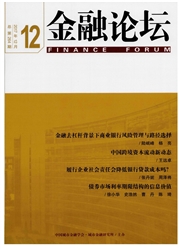

 中文摘要:
中文摘要:
净利差是现阶段中国商业银行收入的主要来源,其水平的高低可以反映出商业银行竞争程度与市场化程度的进展。本文在总结归纳出利差水平决定的“成本驱动效应”、“风险溢价效应”和“规模效应”之后,通过实证分析检验不同效应在中国商业银行的净利差水平中的决定作用。结论支持了后两种效应:风险溢价效应是影响净利差水平的最主要因素,不同规模的商业银行净利差水平的影响因素是不同的。在利率市场化的背景下,银行应提高对自身各种风险的计量能力,并逐步建立适度微调自身净利差水平的机制,使其成为应对环境变化和打造核心竞争力的重要手段。
 英文摘要:
英文摘要:
Net interest margin is the main profit resource for Chinese commercial banks, the level of which can reflect their competition status and the extent of market-oriented reform. The paper first raises three hypotheses to explain net interest margin, which are cost-driven, risk compensation and scale effect. Then the paper empirically tests the dominant effect in determining the level of net interest margin. The result indicates that the latter two effects are dominant ones. Risk compensation is the most important factor to determine net interest margin, and commercial banks with different scale are influenced by different factors. Under the background of interest rate liberalization, commercial bank should improve their ability to measure various risks and gradually establish net interest margin adjustment mechanism, which will serve as an important approach to respond to fierce competition and environment changes, as well as forge their core competence.
 同期刊论文项目
同期刊论文项目
 同项目期刊论文
同项目期刊论文
 期刊信息
期刊信息
